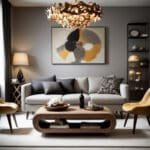The Cost-Plus System in Interior Design: A Flexible and Effective Approach for Clients
When it comes to interior design, one of the most critical aspects of any project is budgeting. Traditionally, many designers and firms have relied on a fixed price per square meter to estimate costs. While this method has its merits, it often lacks the flexibility and transparency that modern clients desire. Enter the cost-plus system—a pricing model that adds a percentage markup for finishing costs rather than relying on a fixed rate per square meter. This approach is gaining traction in the industry for its adaptability and client-centric benefits. In this article, we’ll explore why the cost-plus system is a game-changer and how it offers a more effective and flexible solution for interior design projects.
Understanding the Cost-Plus System
The cost-plus system is straightforward yet highly effective. Instead of charging a flat rate based on the size of the space, the designer calculates the total cost of materials, labor, and other expenses, then adds a percentage markup to cover their fee. This markup is often referred to as the “finishing cost.” For example, if the total cost of materials and labor for a project is $50,000 and the agreed-upon percentage is 20%, the designer’s fee would be $10,000, bringing the total to $60,000.
Why the Cost-Plus System Works Better for Clients
- Transparency and Trust
One of the biggest advantages of the cost-plus system is transparency. Clients can see exactly where their money is going, from material costs to labor expenses. This level of detail fosters trust between the client and the designer, as there are no hidden fees or ambiguous charges. - Flexibility in Design Choices
With a fixed price per square meter, clients often feel constrained in their choices, as they must adhere to a predetermined budget that may not account for unique preferences or upgrades. The cost-plus system, on the other hand, allows for greater flexibility. Clients can choose premium materials or additional features without being limited by a rigid pricing structure. - Tailored Budgeting
Every interior design project is unique, and so are the needs and preferences of each client. The cost-plus system enables a more tailored approach to budgeting, ensuring that the final cost aligns closely with the client’s vision and priorities. Whether the client wants to splurge on custom furniture or save on certain finishes, the cost-plus model accommodates these decisions seamlessly. - Avoiding Overpricing
Fixed price per square meter models often include a buffer to account for unforeseen expenses, which can lead to overpricing. In contrast, the cost-plus system ensures that clients pay only for what they use, making it a more cost-effective option in many cases. - Encourages Collaboration
The cost-plus system encourages collaboration between the client and the designer. Since the pricing model is open and flexible, clients feel more involved in the decision-making process, resulting in a final design that truly reflects their tastes and lifestyle.
Real-Life Applications of the Cost-Plus System
Imagine a client who initially plans for a minimalist design but later decides to incorporate high-end finishes and custom-built furniture. With a fixed price per square meter, these changes could lead to significant budget overruns or even require renegotiation. However, with the cost-plus system, the client can easily adjust their budget to accommodate these upgrades, knowing exactly how much the changes will cost.
Similarly, for clients working with a tighter budget, the cost-plus system allows them to prioritize certain elements of the design while scaling back on others, ensuring that the project stays within their financial limits without compromising on quality.
Challenges and Considerations
While the cost-plus system offers numerous benefits, it’s not without its challenges. For instance, clients must trust their designer to provide accurate and fair cost estimates. Additionally, designers need to maintain meticulous records of all expenses to ensure transparency. However, these challenges can be easily mitigated with clear communication and detailed documentation.
Final Thoughts
The cost-plus system is revolutionizing the way interior design projects are priced, offering a more flexible, transparent, and client-friendly alternative to the traditional fixed price per square meter model. By focusing on actual costs and a percentage-based finishing fee, this approach empowers clients to make informed decisions and achieve their dream spaces without unnecessary financial constraints. For designers, it’s an opportunity to build stronger relationships with clients and deliver truly customized solutions.
If you’re planning an interior design project, consider discussing the cost-plus system with your designer. It might just be the key to achieving a space that perfectly balances your vision, budget, and lifestyle.





